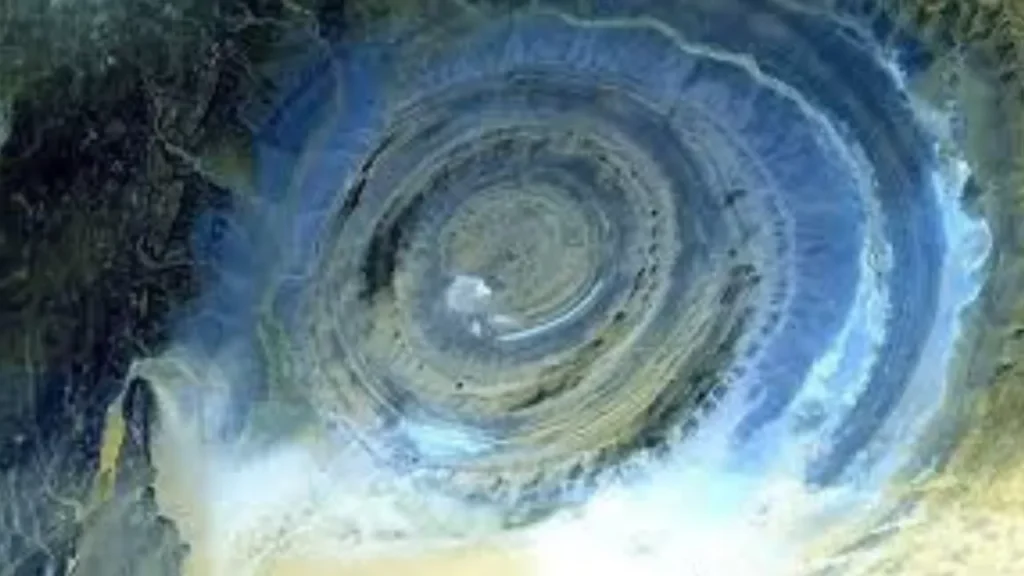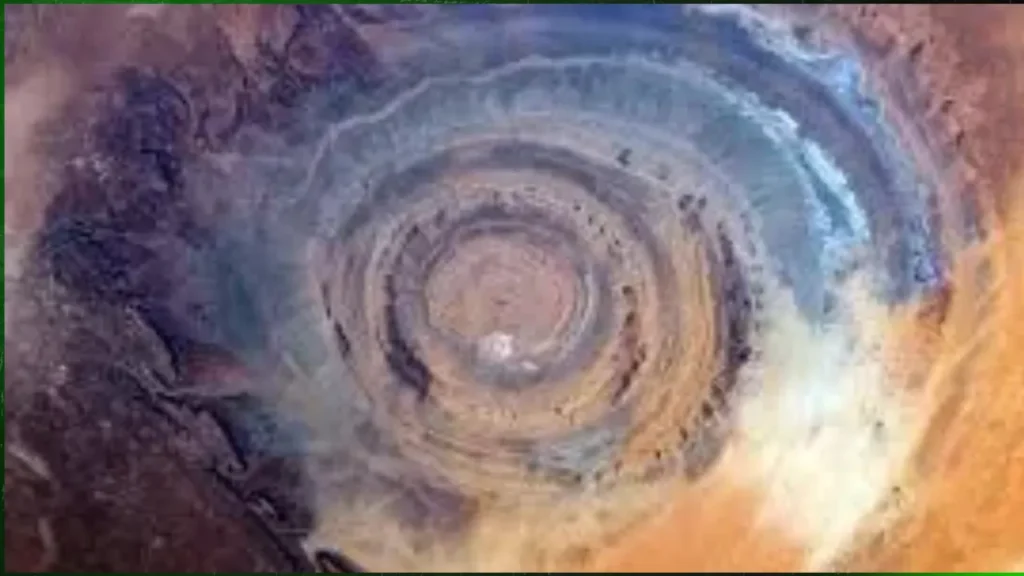The Richat Structure
(The Eye Of Sahara)
Introduction
The Richat Structure, or Guelb er Richât (Arabic: قلب الريشات, romanised: Qalb ar-Rīšāt), often called the Eye of Africa, is a striking circular geological feature on the northwestern edge of the Taoudeni Basin, located on the Adrar Plateau in the Sahara Desert of Mauritania. It lies near the town of Ouadane in the Adrar Region. In Hassaniya Arabic, rīšāt manner “feathers,” and regionally it is also known as tagense, concerning the round beginning of a leather-based pouch used to attract water from wells in recent times. Research shows it is actually a geological dome, uplifted by forces beneath the Earth’s crust and sculpted over millions of years by wind and water erosion. Made of layers of limestone, sandstone, and volcanic rock, its rings tell a story of deep geological time. Yet beyond science, the Richat Structure continues to spark the imagination with some even suggesting it could be linked to the legend of Atlantis.
Location and Size
- Located in the Sahara Desert of Mauritania.
- Measures about 40 km in diameter.
Visibility from Space
- less complicated to look at from a place than from the ground.
- A familiar landmark to astronauts because of the earliest missions
Formation Theories
- Earlier Belief: Formed by a meteor impact.
- Current Belief: Caused by a large dome of molten rock uplifting, later shaped by wind and water.
- Concentric bands of resistant quartzite rocks shape ridges, with valleys of less resistant rock amongst them.
Satellite Observation
Image acquired on 23 November 2010 by the Advanced Visible and Near Infrared Radiometer on Japan’s ALOS satellite
Surrounding Features
- Adrar Plateau: Dark area on the left, made of sedimentary rock, standing about 200 m above the surrounding desert sands.
- Sand Dunes: Large area in the lower right, with sand encroaching on the southern side of the structure.
Seasonal Features
- On the southern side, tiny dots (trees and bushes) follow a dry river-like structure, photographed a few weeks after the rainy season.
- In the south and east, some areas appear covered by temporary lakes, usually dry most of the year.

Is the Richat Structure Natural or Man-Made?
Geologic formatio
Richat (also called Guelb er Richât or the “Eye of Africa”) is a large circular geological dome, not an artificial city. It’s an eroded dome, or an anticline, which has exposed concentric rings of sedimentary, volcanic, and intrusive igneous rock.
Size and Age
- Diameter ≈ 40-50 km (25-30 miles) for the full structure.
- The rocks exposed range widely in age: from Late Proterozoic in the center to Ordovician sedimentary beds around the edges.
- Some of the igneous activity (intrusions, etc.) has been dated to ~100 million years ago (Cretaceous).
Archaeo Facts
- Acheulean stone tools are found around and in parts of the outer ring areas. These are very old (Paleolithic) tools.
- Freshwater fossils / fluvial and playa lake deposits are present, with radiocarbonas ages suggesting those sediments mostly accumulated between 15,000 and 8,000 years before present, during the African Humid Period.
Atlantis in Plato’s Words vs. Modern Claims
Plato’s description of Atlantis in Timaeus and Critias includes various features. Key ones often considered:
- Atlantis had concentric rings of land and water, with the temple, etc, in the centre, rings that may align with circular features.
- The plain around the city was large and flat; there were mountain ranges surrounding it; it was accessible by sea, etc.
- The measure of size in stadia and the orientation toward seas, etc., depend on interpretation.
Claims Supporting Richat = Atlantis
- The concentric ring similarity.
- The existence of freshwater/fossils in the timeframe roughly similar to when some believe Atlantis would have existed (i.e., during periods of sea & rivers) in the past.
- The flat plains around Richat and the natural resources.
Scientific & Skeptical Points
- No archaeological ruins or structures match Atlantis’s described grandeur. Only stone tools, artefacts of Paleolithic / Neolithic origin, and some burial mounds.
- Atlantis was described as an island in the “Atlantic boundless sea.” Richat is inland.
- Timing: The dome, rings, etc., predate human civilization by far.
- Plato’s measurements vs Richat’s real size: Sizes and directions don’t align perfectly.
- Lack of flood/tsunami evidence: No strong evidence of a sudden cataclysmic flood.
- Plato’s Atlantis may be mythical or allegorical. Many historians believe it was symbolic, not literal.
Evidence That Makes the Ricat Theory Believable
- Freshwater fossil deposits and sedimentary layers in outer basins align with scientific data.
- The concentric rings, flatness of outer rings, and level ground are real geological features.
- Speculative but not fully dismissible if one accepts looser interpretations of Plato

To Seriously Argue “Yes,” Evidence Needed
- Clear archaeological evidence of large structures.
- Evidence of catastrophic flooding/tsunami.
- Correlation of size/layout with Plato’s measurements.
- Better match the geographic placement with ocean access.
Salt Evidence Suggesting Ancient Flooding at the Richat Structure
- The Richat Structure is currently over 1200 feet above sea level.
- The area shows white surface blemishes, which are salt deposits visible from the air and satellite imagery.
- The lowest elevation areas of the Richat contain the most salt, supporting the idea of past flooding.
- The southern entrance of the structure also shows noticeable salt.
- Claims suggest the Richat was covered by ocean water about 12,000 years ago due to a cataclysmic flooding event.
- Evidence includes water ripple patterns at Richat, similar to those in Washington State, USA.
- Argument: Such water erosion patterns should have disappeared if they were older, but their presence suggests a recent event.
The Sahara Desert is known to transition every ~20,000 years between lush green jungle and desert.
Frequently asked questions
Why does everyone connect to the Eye of the Sahara to Plato’s Atlantis?
Yes. The structure is located near Ouadane in Mauritania and adventurous travelers may visit with a local guide. As it lies in a remote desert region, visitors should come prepared for tough conditions by bringing adequate supplies as well as employing professional drivers who know the Adrar Plateau well.
Is the Richat Structure open to tourists?
Yes. The structure is located near Ouadane in Mauritania and adventurous travelers may visit with a local guide. As it lies in a remote desert region, visitors should come prepared for tough conditions by bringing adequate supplies as well as employing professional drivers who know the Adrar Plateau well.
What kind of fossils and artifacts have been found at the Richat Structure?
Researchers have unearthed Acheulean stone tools and freshwater fossils dating back 15,000-8,000 years from Africa’s Humid Period (roughly 15,000-8,000 years ago), suggesting humans once lived nearby when the Sahara was greener – though no signs exist of an advanced civilisation having once flourished here.
Can visitors actually see the Richat Structure from the ground?
Richat Structure is massive – nearly 40 km wide! However, its circular form is best observed from above. On the ground, you’ll mostly encounter rocky ridges and valleys; to experience its true “Eye of Africa” effect requires aerial photographs or satellite imagery.
